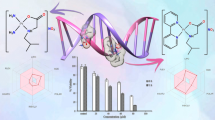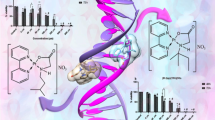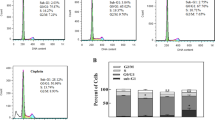Abstract
In this study, several cisplatin analogs were designed to investigate the antitumor activity and lipophilicity effects in amine change. The amines of the cisplatin molecule were substituted with aliphatic amines in different analogs. The cytotoxicity of analogs against human colon cancer (HCT116) was investigated using MTT assay, and spectroscopic methods were used to determine the DNA binding mode. Cytotoxicity studies revealed cis-dichloro-dimethylamine-platinum has a lower IC50 (48.87 µM) than carboplatin (68.46 µM) and more than cisplatin (21 µM) against human colon cancer cells (HCT116), respectively. DNA denaturation study indicated that the stability of DNA in the presence of these compounds diminished and substitution of propylamine and methylamine groups increased DNA denaturation. Further, the interaction of the desired compounds with DNA proved to be a spontaneous process. Tm analysis also revealed that cisplatin, cis-dichloro-dimethylamine-platinum, and cis-dichloro-dipropylamine-platinum complexes made DNA double helix unstable via covalent bond, while cis-dichloro-dibutylamine-platinum and cis-dichloro-diisobutylamine-platinum stabilized DNA via electrostatic binding to DNA. The results of fluorescence studies showed that the quenching nature of cisplatin and methyl and propyl systems was dynamic, while the static quenching was observed in the presence of cis-dichloro-dibutylamine-platinum and cis-dichloro-diisobutylamine-platinum. The molecular docking simulations and DFT analysis were performed to investigate the binding sites and chemical behavior of cisplatin analogs, respectively. Molecular docking demonstrated that except cis-dichloro-diisobutylamine-platinum, other complexes had higher negative docking energy than cisplatin for interaction with DNA, and methyl and propyl complexes may be good candidates for anticancer drugs.
Graphical abstract
Some anticancer Pt(II) complexes as cisplatin analogs were synthesized with aliphatic amines to investigate the lipophilicity effects. In vitro cytotoxicity effects were tested against human colon cancer (HCT116). Moreover, the modes of DNA binding with synthesized compounds were investigated using fluorescence spectra, DFT and molecular docking.









Similar content being viewed by others
Abbreviations
- DNA:
-
Deoxyribonucleic acid
- EB:
-
Ethidium bromide
- CT-DNA:
-
Calf thymus DNA
- DFT:
-
Density functional theory
- ADT:
-
AutoDock tools
- HOMO:
-
Highest occupied molecular orbital
- LUMO:
-
Lowest unoccupied molecular orbital
- NBO:
-
Natural orbital bond analysis
References
A. Basu, S. Krishnamurthy, Cellular responses to cisplatin-induced DNA damage. J. Nucl. Acids (2010). https://doi.org/10.4061/2010/201367
S.E. Sherman, D. Gibson, A.H. Wang, S.J. Lippard, X-ray structure of the major adduct of the anticancer drug cisplatin with DNA: cis-[Pt(NH3)2(d(pGpG))]. Science 230(4724), 412–417 (1985). https://doi.org/10.1126/science.4048939
I.W. Achkar, N. Abdulrahman, H. Al-Sulaiti, J.M. Joseph, S. Uddin, F. Mraiche, Cisplatin based therapy: the role of the mitogen activated protein kinase signaling pathway. J. Transl. Med. 16(1), 96 (2018)
S. Manohar, N. Leung, Cisplatin nephrotoxicity: a review of the literature. J. Nephrol. 31(1), 15–25 (2018). https://doi.org/10.1007/s40620-017-0392-z
R. Oun, Y.E. Moussa, N.J. Wheate, The side effects of platinum-based chemotherapy drugs: a review for chemists. Dalton Trans. 47(19), 6645–6653 (2018). https://doi.org/10.1039/C8DT00838H
D.F. Long, A.J. Repta, Cisplatin: chemistry, distribution and biotransformation. Biopharm. Drug Dispos. 2(1), 1–16 (1981). https://doi.org/10.1002/bdd.2510020102
N. Shah, D.S. Dizon, New-generation platinum agents for solid tumors. Future Oncol. 5(1), 33–42 (2009). https://doi.org/10.2217/14796694.5.1.33
H. Cui, R. Goddard, K.R. Pörschke, A. Hamacher, M.U. Kassack, Bispidine analogs of cisplatin, carboplatin, and oxaliplatin. Synthesis, structures, and cytotoxicity. Inorg. Chem. 53(7), 3371–3384 (2014). https://doi.org/10.1021/ic402737f
D.S. Goodsell, The molecular perspective: cisplatin. Stem Cells. 24(3), 514–515 (2006). https://doi.org/10.1634/stemcells.2006-CSC2
S. Ghosh, Cisplatin: the first metal based anticancer drug. Bioorg. Chem. 88, 102925 (2019). https://doi.org/10.1016/j.bioorg.2019.102925
A.M. Yassin, M. Elnouby, N.M. El-Deeb, E.E. Hafez, Tungsten oxide nanoplates; the novelty in targeting metalloproteinase-7 gene in both cervix and colon cancer cells. Appl. Biochem. Biotechnol. 180(4), 623–637 (2016). https://doi.org/10.1007/s12010-016-2120-x
R.K. Kesharwani, V. Srivastava, P. Singh, S.I. Rizvi, K. Adeppa, K. Misra, A novel approach for overcoming drug resistance in breast cancer chemotherapy by targeting new synthetic curcumin analogues against aldehyde dehydrogenase 1 (ALDH1A1) and glycogen synthase kinase-3 β (GSK-3β). Appl. Biochem. Biotechnol. 176(7), 1996–2017 (2015). https://doi.org/10.1007/s12010-015-1696-x
K.M. Deo, D.L. Ang, B. McGhie, A. Rajamanickam, A. Dhiman, A. Khoury, J. Holland, A. Bjelosevic, B. Pages, C. Gordon, J.R. Aldrich-Wright, Platinum coordination compounds with potent anticancer activity. Coord. Chem. Rev. 375, 148–163 (2018)
E. Pantoja, A. Álvarez-Valdés, J.M. Pérez, C. Navarro-Ranninger, J. Reedijk, Synthesis and characterization of new cis-[PtCl2(isopropylamine)(amine)] compounds: cytotoxic activity and reactions with 5-GMP compared with their trans-platinum isomers. Inorg. Chim. Acta 339, 525–531 (2002)
F. Safa Shams Abyaneh, M. Eslami Moghadam, M. Hossaini Sadr, A. Divsalar, Effect of lipophilicity of amylamine and amylglycine ligands on biological activity of new anticancer cisplatin analog. J. Biomol. Struct. Dyn. 36(4), 893–905 (2018). https://doi.org/10.1080/07391102.2017.1301273
E. Bersanetti, A. Pasini, Antitumor complexes of platinum with carrier molecules. 2 [1]. Mixed complexes of amino acids and tert-butylamine. Inorg. Chim. Acta 93, 167–172 (1984). https://doi.org/10.1016/S0020-1693(00)88158-X
G.R. Gale, M.G. Rosenblum, L.M. Atkins, E.M. Walker Jr., A.B. Smith, S.J. Meischen, Antitumor action of cis-Dichlorobis(methylamine)platinum(II). J. Natl. Cancer Inst. 51(4), 1227–1234 (1973). https://doi.org/10.1093/jnci/51.4.1227
S. Wimmer, F. Wimmer, J. Jaud, N.P. Johnson, P. Castan, A Study of cis-Dichlorobis(methylamine)platinum(II): crystal and molecular structures of two crystal forms. Inorg. Chim. Acta 144, 25–30 (1988). https://doi.org/10.1016/S0020-1693(00)80962-7
M.J. Cleare, J.D. Hoeschele, Studies on the antitumor" activity of group VIII transition metal complexes. Part I. Platinum (II) complexes. Bioinorg. Chem. 2(3), 187–210 (1973). https://doi.org/10.1016/S0006-3061(00)80249-5
F. Safa Shams Abyaneh, M. Eslami Moghadam, A. Divsalar, D. Ajloo, M. Hosaini Sadr, Improving anticancer activity and solubility of cisplatin by methylglycine and methyl amine ligands against human breast adenocarcinoma cell line. Appl. Biochem. Biotechnol. 186, 271–291 (2018). https://doi.org/10.1007/s12010-018-2715-5
M. Kantoury, M. Eslami Moghadam, A.A. Tarlani, A. Divsalar, Structure effect of some new anticancer Pt(II) complexes of amino acid derivatives with small branched or linear hydrocarbon chains on their DNA interaction. Chem. Biol. Drug Des. 88(1), 76–87 (2016). https://doi.org/10.1111/cbdd.12735
M. Eslami Moghadam, M. Saidifar, A. Divsalar, H. Mansouri-Torshizi, A.A. Saboury, H. Farhangian et al., Rich spectroscopic and molecular dynamic studies on the interaction of cytotoxic Pt(II) and Pd(II) complexes of glycine derivatives with calf thymus DNA. J. Biomol. Struct. Dyn. 34(1), 206–222 (2016). https://doi.org/10.1080/07391102.2015.1015056
R.F. Greene, C.N. Pace, Urea and guanidine hydrochloride denaturation of ribonuclease, lysozyme, alpha-chymotrypsin, and beta-lactoglobulin. J. Biol. Chem. 249(17), 5388–5393 (1974)
M. Jain, R. Nilsson, S. Sharma, N. Madhusudhan, T. Kitami, A.L. Souza, R. Kafri, M.W. Kirschner, C.B. Clish, V.K. Mootha, Metabolite profiling identifies a key role for glycine in rapid cancer cell proliferation. Science 336(6084), 1040–1044 (2012). https://doi.org/10.1126/science.1218595
G.M. Morris, R. Huey, W. Lindstrom, M.F. Sanner, R.K. Belew, D.S. Goodsell et al., AutoDock4 and AutoDockTools4: automated docking with selective receptor flexibility. J. Comput. Chem. 30(16), 2785–2791 (2009). https://doi.org/10.1002/jcc.21256
S. Neidle, E.L. Rayner, I.J. Simpson, N.J. Smith, J. Mann, A. Baron et al., Symmetric bis-benzimidazoles: new sequence-selective DNA-binding molecules. Chem. Commun. (1999). https://doi.org/10.1039/a901074b
M. Heydari, M.E. Moghadam, A.A. Tarlani, H. Farhangian, DNA as a target for anticancer Phen-Imidazole Pd(II) complexes. Appl. Biochem. Biotechnol. 182(1), 110–127 (2017). https://doi.org/10.1007/s12010-016-2314-2
S. Shahraki, H. Mansouri-Torshizi, A. Heydari, A. Ghahghaei, A. Divsalar, A.A. Saboury et al., Platinum(II) and Palladium(II) complexes with 1,10-phenanthroline and pyrrolidinedithiocarbamato ligands: synthesis, DNA-binding and anti-tumor activity in leukemia K562 cell lines. Iran. J. Sci. Technol. (Sciences) 39(2), 187–198 (2015). https://doi.org/10.22099/ijsts.2015.3018
H. Mansouri-Torshizi, S. Shahraki, Z.S. Nezami, A. Ghahghaei, S. Najmedini, A. Divsalar et al., Platinum(II)/palladium(II) complexes with n-propyldithiocarbamate and 2,2′-bipyridine: synthesis, characterization, biological activity and interaction with calf thymus DNA. Complex Metals 1(1), 23–31 (2014). https://doi.org/10.1080/2164232X.2014.883288
H. Farhangian, M. Eslami Moghadam, A. Divsalar, A. Rahiminezhad, Anticancer activity of novel amino acid derivative of palladium complex with phendione ligand against of human colon cancer cell line. J. Biol. Inorg. Chem. 22(7), 1055–1064 (2017). https://doi.org/10.1007/s00775-017-1483-y
A. Divsalar, A.A. Saboury, H. Mansoori-Torshizi, M.I. Moghaddam, F. Ahmad, G.H. Hakimelahi, Comparative studies on the interaction between bovine β-lacto-globulin type A and B and a new designed Pd(II) complex with anti-tumor activity at different temperatures. J. Biomol. Struct. Dyn. 26(5), 587–597 (2009). https://doi.org/10.1080/07391102.2009.10507274
M.A. Grant, R.M. Baron, A.A. Macias, M.D. Layne, M.A. Perrella, A.C. Rigby, Netropsin improves survival from endotoxaemia by disrupting HMGA1 binding to the NOS2 promoter. Biochem. J. 418(1), 103–112 (2009). https://doi.org/10.1042/BJ20081427
R. Mital, N. Jain, T.S. Srivastava, Synthesis, characterization and cytotoxic studies of diamine and diimine palladium(II) complexes of diethyldithiocarbamate and binding of these and analogous platinum(II) complexes with DNA. Inorg. Chim. Acta 166(1), 135–140 (1989). https://doi.org/10.1016/S0020-1693(00)80798-7
H.F. Crouse, E.M. Petrunak, A.M. Donovan, A.C. Merkle, B.L. Swartz, S. Basu, Static and dynamic quenching of tryptophan fluorescence in various proteins by a Chromium (III) complex. Spectrosc. Lett. 44(5), 369–374 (2011). https://doi.org/10.1080/00387010.2010.546470
C. Wang, Q.-H. Wu, Z. Wang, J. Zhao, Study of the interaction of carbamazepine with bovine serum albumin by fluorescence quenching method. Anal. Sci. 22(3), 435–8 (2006). https://doi.org/10.2116/analsci.22.435
P. Zhang, J. Chen, Y. Liang, DNA binding, cytotoxicity, and apoptotic-inducing activity of ruthenium(II) polypyridyl complex. Acta Biochim. Biophys. Sin. 42(7), 440–449 (2010). https://doi.org/10.1093/abbs/gmq040
J. Reedijk, Why does cisplatin reach Guanine-N7 with competing S-donor ligands available in the cell? Chem. Rev. 99(9), 2499–2510 (1999). https://doi.org/10.1021/cr980422f
Acknowledgements
The authors would like to gratefully appreciate the Chemistry & Chemical Engineering Research Center of Iran for financially supporting this project. Also, the authors would like to thank Dr. Samaneh Zolghadri from the Department of Biology, Islamic Azad University, Jahrom Branch, Fars province, Iran, for her advices in analyzing the cytotoxicity results.
Author information
Authors and Affiliations
Corresponding author
Ethics declarations
Conflict of interest
It is declared authors have no conflict of interest in cooperation.
Supplementary Information
Below is the link to the electronic supplementary material.
Rights and permissions
About this article
Cite this article
Rahiminezhad, A., Eslami Moghadam, M., Divsalar, A. et al. In vitro activity, stability, and lipophilicity changes of cisplatin through substitution of different amine ligands. J IRAN CHEM SOC 19, 2749–2768 (2022). https://doi.org/10.1007/s13738-022-02491-1
Received:
Accepted:
Published:
Issue Date:
DOI: https://doi.org/10.1007/s13738-022-02491-1




